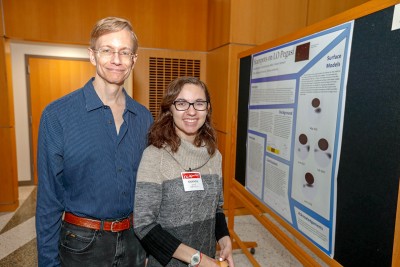Abstract
Starspots on LO Pegasi
 Students: Amanda Jewell and Brooke Kimsey-Miller (Indiana University)
Students: Amanda Jewell and Brooke Kimsey-Miller (Indiana University)
Faculty Mentor: Robert Harmon (OWU Department of Physics and Astronomy)
Sunspots are regions of strong magnetic fields on the sun’s surface that have been cooled and thereby darkened by the interactions between these fields and the gas that makes up the star. Sunspots never cover more than about 2% of the sun’s surface, but sunspots on other stars, which are called starspots, can cover a much larger fraction of the surface. LO Pegasi is a star whose starspots are large enough that their impact on its brightness is easily detectable through a telescope as LO Pegasi rotates every 10.153 hours. We used a CCD (specialized digital) camera to take photos through our telescope that we then analyzed with a standard astronomical technique called aperture photometry in order to measure its variations in brightness over time. We collected data over three nights in July (7-9) 2018 and then entered the data into a program that uses the star’s brightness variations to create a model of LO Pegasi’s surface and starspots.
Star spots are cooler, darker regions on the surface of a star in which strong magnetic field's cause the suppression of convection, which is the primary method of energy transfer in the outer layers of sun – like stars. LO Pegasi is a young, sunlike star whose starspots can cover a significant fraction of the stars surface. Comparatively, the sons of sunspots are much smaller and can only cover about 2% of its service: LO Pegasi is much faster rotation (10.153 hours versus the suns ~30 days) induces a much stronger magnetic field, which in turn causes the spots to be much larger than on the Sun. As the spots come in or out of view on the side of the star facing earth, they can have significant impact on measure brightness. We acquired CCD camera images over three nights 7–9 July 2018, through standard astronomical B, V, R, and I filters. The brightness variations of LO Pegasi were determined using differential aperture photometry by comparing it to a known, stable reference star. These brightness variations were then input into a light curve inversion program to produce maps of starspot distribution across the surface. These plots and models are presented and compared to previous years’ findings to determine how the surface of LO Pegasi has changed over time.
